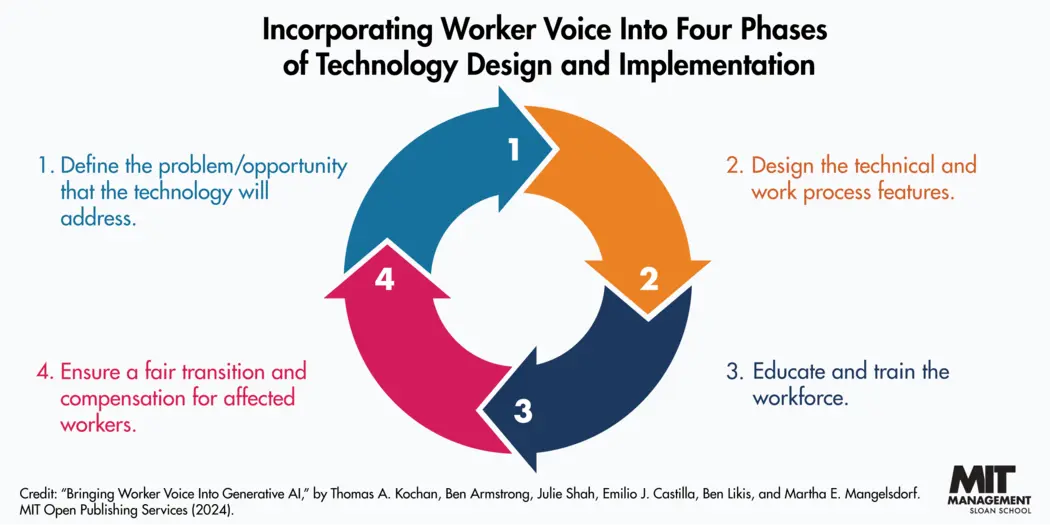Credit: Mimi Phan / Anton Vierietin / iStock
The secret to successful AI implementations? Worker voice
As organizations begin to understand the capabilities and effects of generative artificial intelligence, a group of MIT experts hopes a new framework for technology design and implementation will inspire leaders to include worker voice in their decision-making.
In a new paper, “Bringing Worker Voice Into Generative AI,” the researchers explain that generative AI is “well-suited to bottom-up development and use.” They also contend that the more that stakeholders are involved in defining the problems and opportunities the technology can address, “the more likely it is that these tools will be used to augment how workers do their jobs rather than displace them.”
The paper was written by Ben Armstrong, Julie Shah, Ben Likis, and Martha E. Mangelsdorf, all of MIT. It draws on more than 50 interviews with academics, business managers, AI experts, and labor leaders and is also guided by the researchers’ earlier work.
“I know from prior work that I’ve done in automation and robotics, the most successful applications of automation were those where the engineers were working side by side with those on the shop floor or those with the domain expertise,” said Shah, professor and department head at the MIT Department of Aeronautics and Astronautics, in an interview. “The opportunity here is to follow that same playbook so that generative AI can have the positive outcomes that we hope it will have.”
Here’s a closer look at the four stages of technology design and implementation where leaders should solicit input from their workers.
1. Defining the problem or opportunity the technology will address
As a business prepares to invest in generative AI, it might seem logical to create a task force of senior-level or C-suite executives to decide use cases and where to implement the technology, Armstrong said. After all, they’re the employees who know the direction in which the company wants to go.
A better approach is to apply an inverse perspective, “which takes worker voice a lot more seriously,” said Armstrong, executive director of the MIT Industrial Performance Center and co-lead of the Work of the Future initiative. In these cases, leaders establish an open line of communication with, and ask for feedback from, their front-line employees — especially those doing routine work that could be augmented by AI.
At those companies, “there’s a channel for any worker, at any level of the company, to say, ‘Hey, I have an idea that this technology might be useful for,’” Armstrong said.
2. Designing the needed technical and work process features
Worker voice can also be included through experimentation with a new technology and participatory design practices and events.
Employees who know a work process very well can meet with generative AI vendors to discuss their work, what they need, and how the AI tool could be updated or built around their process.
Another approach is to upskill those workers in generative AI or robotic process automation. “That gives the process expert some extra technical expertise,” Armstrong said. “Instead of having one person who’s the business partner consulting for the front lines, it takes the front-line worker and gives them a boost.”
3. Educating and training the workforce in the skills needed
Worker voice is important for understanding business processes and daily tasks, and it becomes even more valuable when those workers get the chance to use the AI tools being implemented to improve their work processes and outputs.
Consider U.S. schools and teachers unions that have adopted remote learning and associated AI tools post-pandemic, said Kochan, emeritus professor of management at MIT Sloan. Rather than banning the technology from their classrooms, teachers took the initiative to learn and apply it to their work and suggested where and when to put guidelines in place.
“That technology really opened up some new opportunities for individual learning and supplementing what the teachers can do personally,” Kochan said. “And the unions are working with some of the education technology vendors to say, ‘Let’s not naively argue that this technology is going to replace the human teacher, but let’s figure out how we can use it to augment what we do.’”

Leading the AI-Driven Organization
In person at MIT Sloan
Register Now
4. Ensuring a fair transition and compensation for affected workers
It’s not known just how many workers will see their work augmented or replaced by generative AI, but the researchers write that “regardless of the size or pace of displacement, actions are needed to ensure fair transition/adjustment processes, policies, and practices.”
This responsibility will largely fall on employers and unions, the researchers write, since they have a long history of negotiating in areas like worker reskilling, pay adjustments, severance packages, and retirement incentives.
“Protections against monitoring of work or personal activities, use of personal data, and use of AI-generated data for disciplinary actions are also getting negotiated into bargaining agreements where needed,” the researchers write.
A broad example of this is a December 2023 agreement between Microsoft and the AFL-CIO. The partnership created “an open dialogue to discuss how artificial intelligence must anticipate the needs of workers and include their voices in its development and implementation,” according to a Microsoft press release.
The partnership established three goals: that Microsoft will provide labor leaders and workers with information about AI developments; that worker perspectives and expertise will be shared with Microsoft AI developers to inform their technology development; and that Microsoft and the AFL-CIO will work together to help shape public policy that supports front-line workers’ technology skills and needs.
Though still in its early stages, Kochan said, the partnership is a “positive development” and shows how some unions are working with — rather than opposing — technology vendors.





